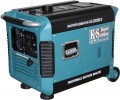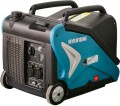Max. power
The maximum power output that the generator can provide.
This power is slightly higher than the nominal (see above), but the maximum performance mode can only be maintained for a very short time - otherwise an overload occurs. Therefore, the practical meaning of this characteristic is mainly to describe the efficiency of the generator when working with increased starting currents.
Let us recall that some types of electrical appliances consume several times more power (and, accordingly, power) at the moment of starting than in the normal mode; this is typical mainly for devices with electric motors, such as power tools, refrigerators, etc. However, increased power for such equipment is needed only for a short time, normal operation is restored in literally a few seconds. And you can estimate the starting characteristics by multiplying the nominal power by the so-called starting coefficient. For equipment of the same type, it is more or less the same (1.2 - 1.3 for most power tools, 2 for a microwave oven, 3.5 for an air conditioner, etc.); more detailed data is available in special sources.
Ideally, the maximum power of the generator should be no less than the total peak power of the connected load - that is, the starting power of equipment with a starting factor greater than 1 plus the rated power of all other equipment. This will minimize the likelihood of overloads.
Motor type
Model name of the engine installed in the generator. Knowing this name, you can, if necessary, find detailed data on the engine and clarify how it meets your requirements. In addition, model data may be needed for some specific tasks, including maintenance and repair.
Note that modern generators are often equipped with
branded engines from famous manufacturers: Honda, John Deere, Mitsubishi, Volvo, etc. Such engines are more expensive than similar units from little-known brands, but this is offset by higher quality and/or solid warranty conditions , and in many cases, the ease of finding spare parts and additional documentation (such as manuals for special maintenance and minor repairs).
Engine size
The working volume of the engine in a gasoline or diesel generator (see "Fuel"). Theoretically, more volume usually means more power, but in fact, everything is not so clear. Firstly, the specific power strongly depends on the type of fuel, and in gasoline units, also on the type of internal combustion engine (see above). Secondly, similar engines of the same power can have different volumes, and there is a practical point here: with the same power, a larger engine consumes more fuel, but by itself it can cost less.
Power
The operating power of the engine installed in the generator. Traditionally stated in horsepower; 1 HP approximately equal to 735 watts.
First of all, the rated power of the generator directly depends on this indicator (see above): in principle, it cannot be higher than the engine power, moreover, part of the engine power is spent on heat, friction and other losses. And the smaller the difference between these capacities, the higher the efficiency of the generator and the more economical it is. However high efficiency affects the cost, but this difference can pay off with regular use due to fuel savings.
Starter type
Method of starting the electric generator engine. To start the internal combustion engine (petrol or diesel, see "Fuel"), it is necessary to turn the engine shaft in any case; this can be done in two ways:
—
Manual. With this method of starting, the initial impulse is transmitted to the engine manually - usually the user needs to pull hard on the cable that spins a special flywheel. The simplest in design and cheapest method of starting, from additional equipment it requires only the cable itself with a flywheel. On the other hand, it may require the user to apply significant muscular effort and is poorly suited for high-power units.
—
Electric starter. With this type of start, the engine shaft is rotated by a special electric motor, which is called a starter; the starter is powered by its own battery. This option for starting the generator power unit is the easiest for the user and requires a minimum of effort. Depending on the implementation of the electric starter, it is usually enough to turn the key in the ignition switch, press a button, turn the handle or rotate a special drum, etc. The power of modern starters is sufficient even for heavy engines, where manual starting is difficult or impossible. Also note that an electric starter is required by definition to use the ATS autostart (see "Features"). On the other hand, additional equipment affects the weight and cost of the unit,
...and sometimes quite noticeably. Therefore, such starting systems are used mainly where they cannot be avoided - in the aforementioned heavy equipment, as well as generators with ATS.Fuel consumption (50% load)
Fuel consumption of a petrol or diesel generator when operating at half power, and for combined models when using petrol (see “Fuel”).
Fuel consumption usually increases with load. However, generator efficiency is not always linear - fuel consumption may vary disproportionately with different loads. In this case, the approximate amount of fuel consumed by the generator when operating at half power (50% of the rated power) is given. Knowing the fuel consumption and tank capacity, you can at least estimate how long one fill-up will last.
Fuel tank volume
The volume of the fuel tank installed in the generator.
Knowing the fuel consumption (see above) and the capacity of the tank, you can calculate the operating time on one gas station (if it is not indicated in the specifications). However, a more capacious tank is also more bulky. Therefore, manufacturers choose tanks based on the general level and "voracity" of the generator — in order to provide an acceptable operating time without a significant increase in size and weight. So in general, this parameter is more of a reference than practically significant.
As for the numbers, in low-power models, tanks are installed for
5 – 10 liters, or even
less ; in heavy professional equipment, this figure can
exceed 50 liters.
Fuel level indicator
A pointer that allows you to monitor the remaining fuel in the generator tank. The simplest such
indicators work only with a critical decrease in the level of fuel, warning of the need for refueling; more advanced ones constantly display the remainder. However, anyway, this feature makes it easier to keep track of the fuel supply and reduces the risk of a generator shutdown due to a forgotten refueling.
Protection level
The level of protection provided by the generator housing — namely, the degree of protection of the “hardware” from dust, moisture and foreign objects. It is designated by the IP standard with two numbers, one of which corresponds to protection against solid objects and dust, the second — from moisture, for example, IP24.
According to the level of dust protection (first digit) in modern generators, the following values \u200b\u200bare found:
2 — protection against objects with a diameter of more than 12.5 mm (fingers, etc.);
3 — from objects larger than 2.5 mm (most instruments);
4 — from objects more than 1 mm (almost all tools, most wires);
5 — dustproof (full protection against contact; dust can penetrate inside, but does not affect the operation of the device).
Water protection levels can be as follows:
1 — protection against vertically falling drops of water;
2 — from water drops with a deviation of up to 15 ° from the vertical axis of the device (rain);
3 — from water drops with a deviation of up to 60 ° from the vertical axis of the device (rain with wind);
4 — against splashes from any direction (rain with strong wind);
In general, for indoor use, this indicator does not play a key role, but on the street and in similar conditions (for example, at a construction site), you should make sure that the selected generator is sufficiently protected — or else take additional protection measures.

